| Cold War | |
|---|---|
| 12 March 1947 – 26 December 1991[A] (44 years and 9 months) Part of the post-World War II era | |
 NATO and Warsaw Pact states during the Cold War era | |
 The "Three Worlds" of the Cold War era, between 30 April and 24 June 1975:
|
| Part of a series on |
| History of the Cold War |
|---|
 |
The Cold War was a period of global geopolitical tension and struggle for ideological and economic influence between the United States and the Soviet Union (USSR) and their respective allies, the Western Bloc and the Eastern Bloc, that started in 1947, two years after the end of World War II, and lasted until the fall of the Soviet Union in 1991. The term cold war is used because there was no direct fighting between the two superpowers, though each supported opposing sides in major regional conflicts known as proxy wars. Aside from the nuclear arms race starting in 1949 and conventional military deployment, the struggle for dominance was expressed indirectly via psychological warfare, propaganda campaigns, espionage, far-reaching embargoes, sports diplomacy, and technological competitions such as the Space Race.
The US and USSR were both part of the Allies of World War II, the military coalition which had defeated Nazi Germany and Imperial Japan in 1945.[1] After the war, the USSR installed satellite governments in the territories of Eastern and Central Europe it had occupied, and promoted the spread of communism to North Korea in 1948 and created an alliance with the People's Republic of China in 1949. The US declared the Truman Doctrine of "containment" in 1947, launched the Marshall Plan in 1948 to assist Western Europe's economic recovery, and founded the NATO military alliance in 1949 (which was matched by the Soviet-led Warsaw Pact in 1955). Germany's split occupation zones solidified into East and West Germany in 1949. The first major proxy war of the period was the Korean War from 1950 to 1953, which ended in stalemate.
In 1962, the Cuban Missile Crisis began after deployments of U.S. missiles in Europe and Soviet missiles in Cuba; it is widely considered the closest the Cold War came to escalating into full-scale nuclear war. Another major proxy conflict was the Vietnam War of 1955 to 1975; the Soviets solidified their domination of Eastern Europe with operations such as the Warsaw Pact invasion of Czechoslovakia in 1968. Both powers used economic aid in an attempt to win the loyalty of non-aligned countries, such as India. By the 1970s, Japan and Western Europe rebuilt their economies, allowing them more diplomatic independence. After the Sino-Soviet split between the USSR and China in 1961, the U.S. initiated contacts with China in 1972. In the same year, the US and USSR signed a series of treaties limiting their nuclear arsenals, which eased tensions for a time. In 1979, the toppling of pro-US governments in Iran and Nicaragua and a Soviet invasion of Afghanistan again raised fears of war. In the 1980s, the US provided support for anti-communist forces in Africa, Asia, and Latin America, and the leadership of the USSR changed with the rise of Mikhail Gorbachev, who expanded political freedoms in his country and the Eastern Bloc. This led to the fall of the communist governments of Europe from 1989, which concluded with the fall of the Soviet Union in 1991.
The Western Bloc included the US and a number of First World nations that were generally capitalist and liberal democratic but tied to a network of often authoritarian Third World states, most of which were the European powers' former colonies.[2][3] The Eastern Bloc was led by the Soviet Union and its communist party, which had an influence across the Second World and was also tied to a network of authoritarian states. The Soviet Union had a command economy and installed similarly communist regimes its in satellites. United States involvement in regime change during the Cold War included support for anti-communist and right-wing dictatorships, governments, and uprisings across the world, while Soviet involvement in regime change included the funding of left-wing parties, wars of independence, revolutions and dictatorships. As nearly all the colonial states underwent decolonization and achieved independence in the period from 1945 to 1960, many became Third World battlefields in the Cold War.
Cite error: There are <ref group=upper-alpha> tags or {{efn-ua}} templates on this page, but the references will not show without a {{reflist|group=upper-alpha}} template or {{notelist-ua}} template (see the help page).
- ^ Sempa 2017, p. [page needed].
- ^ Jones, G. 2014, pp. 176–179.
- ^ T.W. (21 November 2013). "Where did banana republics get their name?". The Economist. Archived from the original on 22 November 2013.